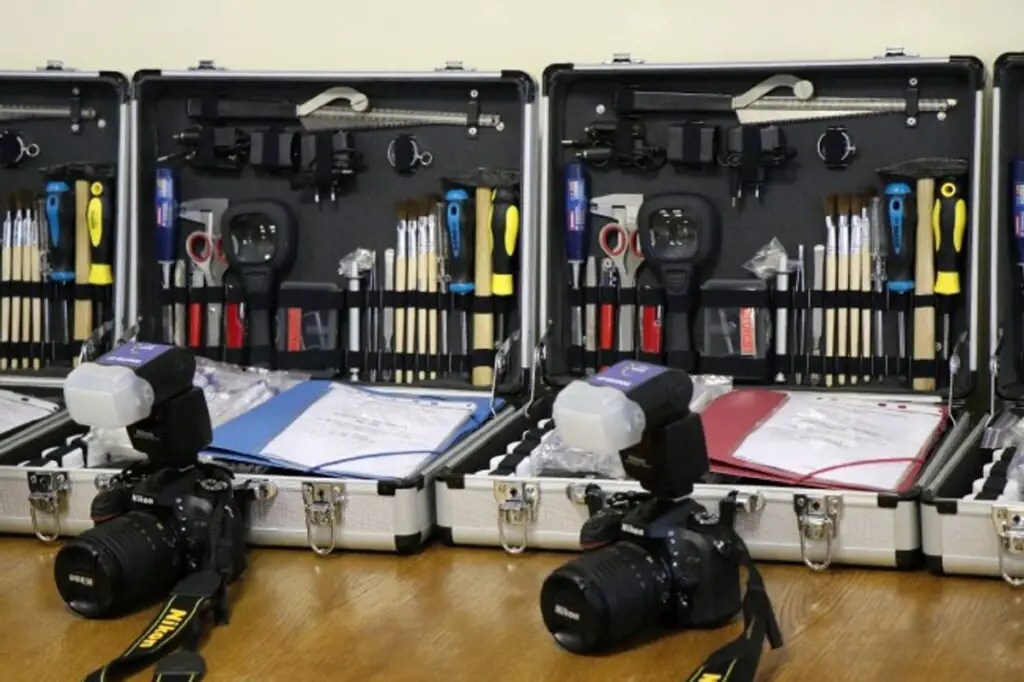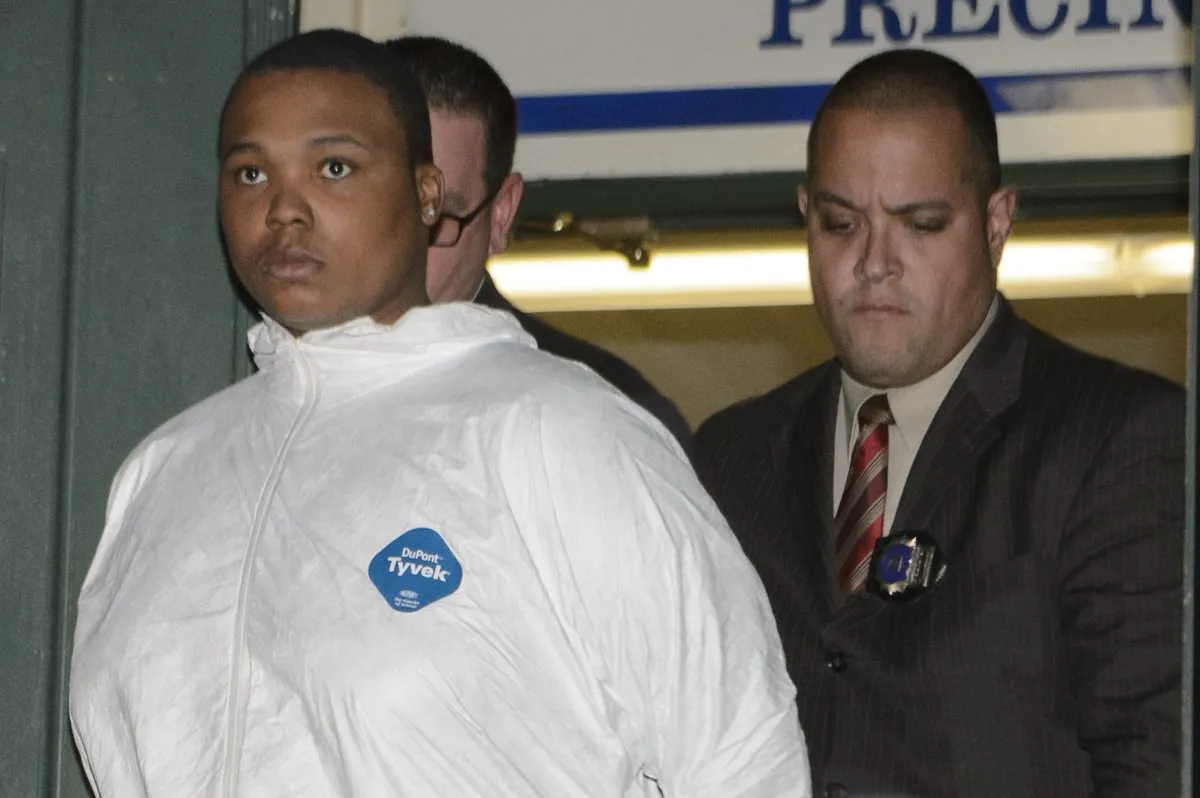Updated on: March 29, 2024
INTRODUCTION
The case of Bahsid McLean stands as one of the most macabre and unsettling incidents in recent memory. In a grotesque act that sent shockwaves through the community and beyond, McLean not only murdered his mother, Tanya Byrd but also took a selfie with her dismembered corpse. This article delves into the chilling details of the crime, explores the complex motives behind McLean’s actions, examines the legal proceedings that followed and reflects on the broader implications of the case, including the media’s role and the aftermath of such a heinous act.
Key Takeaways
- Bahsid McLean committed a heinous crime by murdering his mother and taking a selfie with her corpse, showcasing a disturbing lack of remorse.
- The discovery of the photograph led to McLean’s arrest and confession, revealing the gruesome reality of the crime and the dismemberment of Tanya Byrd.
- McLean’s troubled relationship with his mother and his complex psychological profile were central to understanding the motives behind the murder.
- The trial featured contentious defense strategies centered on McLean’s mental health but ultimately resulted in a guilty verdict and sentencing.
- The case elicited a strong reaction from the media and public, highlighting issues of sensationalism and the lasting impact on the victim’s family and community.
THE GRISLY CRIME OF BAHSID MCLEAN SELFIE
The Murder Of Tanya Byrd

In a chilling turn of events, Tanya Byrd, a 45-year-old mother from the Bronx, fell victim to a heinous crime that would shock the community. Bahsid McLean, her son, was the perpetrator of this unthinkable act. The details of the murder were gruesome, with Tanya Byrd being dismembered post-mortem.
The brutality of the crime was beyond comprehension, with the community struggling to understand how a son could commit such an act against his mother.
The investigation revealed that the murder was premeditated, and the dismemberment was an attempt to conceal the crime. The following points outline the key aspects of the case:
- Tanya Byrd was last seen alive on February 24, 2013.
- Her dismembered body was discovered in trash bags scattered across the Bronx.
- Bahsid McLean took a selfie with his mother’s severed head, a disturbing piece of evidence that would later be pivotal in the case.
Discovery Of The Gruesome Photograph

In the aftermath of the murder, a chilling discovery was made that added a macabre twist to the already horrifying crime. Bahsid McLean took a selfie with his mother’s decapitated head, a grotesque act that shocked even seasoned investigators. This photograph would later become a key piece of evidence in the case against McLean.
The image, which McLean had stored on his cellphone, was uncovered by detectives as they sifted through digital evidence. It was a stark and disturbing testament to the brutality of the crime:
- McLean posed with the severed head in a manner reminiscent of a trophy photo.
- The selfie was taken shortly after the murder, indicating a lack of remorse or understanding of the gravity of his actions.
- The photograph was not shared publicly, but its existence raised questions about McLean’s mental state.
The photograph’s discovery marked a turning point in the investigation, as it provided undeniable proof of McLean’s involvement in the crime and his unsettling detachment from the act.
Bahsid McLean’s Arrest And Confession
Following the horrific murder of Tanya Byrd, her son Bahsid McLean was arrested after evidence surfaced linking him to the crime. McLean’s confession to the murder was a pivotal moment in the case, revealing the chilling details of his actions.
After the discovery of the gruesome photograph, authorities were able to piece together the events leading to Byrd’s death. McLean’s admission provided a harrowing account of the murder, which he claimed was an act of self-defense. The confession included his description of dismembering the body and his attempts to dispose of the evidence.
The case took a disturbing turn when McLean’s confession detailed the dispassionate manner in which he treated his mother’s remains, further shocking the community and law enforcement officials.
The following is a summary of the key points from McLean’s confession:
- Acknowledgment of the murder of Tanya Byrd
- Claim of self-defense as the motive
- Description of the dismemberment process
- Details of the attempt to dispose of the body parts
McLean’s arrest and subsequent confession brought a temporary closure to the search for the perpetrator, but it also opened a new chapter of legal and psychological analysis to understand the underlying factors that led to such a gruesome act.
UNRAVELING THE MOTIVES

The Troubled Relationship
The relationship between Bahsid McLean and his mother, Tanya Byrd, was fraught with tension and complexity. Bahsid’s upbringing was marked by instability and intermittent contact with his mother, which may have contributed to the strained dynamics between them. The lack of a consistent parental presence and the challenges of Tanya’s life circumstances created an environment that was far from nurturing.
- Bahsid’s early childhood involved multiple foster care placements.
- Tanya Byrd struggled with her issues, impacting her ability to provide a stable home.
- The mother-son relationship was characterized by periods of estrangement and reconciliation.
The fabric of their relationship was woven with intermittent threads of care and conflict, which ultimately culminated in a tragic unraveling.
The details of their interactions and the specific events leading up to the crime remain shrouded in ambiguity. However, the bond between them was deeply troubled, setting the stage for the horrific events that would later unfold.
Psychological Profile Of Bahsid McLean
The psychological profile of Bahsid McLean reveals a complex interplay of factors that may have contributed to his heinous act. Experts pointed to a history of mental health issues and a troubled upbringing as potential influences on his behavior.
- History of mental health issues
- Difficult relationship with his mother
- Previous criminal behavior
- Social isolation and lack of support
The deep-seated issues that plagued McLean’s psyche were not enough to fully explain the brutality of the crime, but they provided insight into the disturbed mind behind it.
Further examination indicated that McLean may have suffered from a personality disorder, characterized by a lack of empathy and remorse. This, combined with environmental stressors, could have been a catalyst for the murder.
The Role Of Mental Illness
The case of Bahsid McLean is a stark reminder of the complex interplay between mental illness and criminal behavior. Mental health experts have debated the extent to which McLean’s diagnosed disorders may have influenced his capacity to discern right from wrong. The defense argued that his mental state was a significant factor, potentially diminishing his responsibility for the crime.
- McLean was diagnosed with schizophrenia.
- He exhibited signs of antisocial personality disorder.
- His cognitive abilities were questioned during the trial.
The intersection of mental health and the legal system presents a myriad of challenges, particularly in cases as severe as McLean’s. The court had to consider whether his mental illness could justify a lesser sentence or even an acquittal.
The criminal justice system is often ill-equipped to address the nuances of mental health in the context of criminal acts. This case has prompted discussions on the need for reforms that better accommodate the psychological assessment and treatment of defendants.
THE LEGAL PROCEEDINGS

The Trial And Evidence Presented
The trial of Bahsid McLean was a meticulous affair, with the prosecution presenting a litany of evidence to the jury. The most damning piece was undoubtedly the selfie McLean took with his mother’s decapitated head, a grotesque testament to the heinous nature of the crime.
Key evidence presented at the trial included:
- The infamous selfie photograph
- McLean’s blood-stained clothing
- Forensic testimony linking the tools found in McLean’s apartment to the dismemberment
- Eyewitness accounts of McLean’s behavior before and after the murder
The prosecution aimed to paint a clear picture of premeditation and malice, countering any narrative that might suggest a crime of passion or temporary insanity.
The defense faced an uphill battle, contending with the visceral impact of the photographic evidence and the detailed forensic analysis. Their strategy hinged on questioning the reliability of the forensic evidence and the mental state of McLean at the time of the murder.
Defense Strategies And Mental Health Claims
In the trial of Bahsid McLean, the defense team presented a multifaceted strategy, central to which were claims of their client’s compromised mental health. The argument hinged on McLean’s diagnosed psychiatric disorders, which they posited diminished his criminal responsibility.
The defense’s claims were supported by the testimony of mental health professionals, who detailed McLean’s history with mental illness. This included a diagnosis of schizophrenia, which the defense argued, affected his ability to discern right from wrong.
The defense sought to establish a direct link between McLean’s mental health and the heinous nature of the crime, suggesting that his actions were not entirely within his control.
The prosecution, however, contested these claims, pointing to evidence of premeditation and the calculated steps McLean took following the murder. The jury was left to weigh the complex interplay between mental illness and criminal culpability.
The Verdict And Sentencing
After a trial that gripped the city with its macabre details, Bahsid McLean was found guilty of second-degree murder and mishandling of human remains. The jury delivered the verdict after several hours of deliberation, reflecting the weight of the evidence presented against McLean.
The sentencing phase followed, with the court imposing a severe penalty in light of the heinous nature of the crime:
- Second-degree murder: 25 years to life
- Mishandling of human remains: 1 to 4 years
The sentence handed down was intended to reflect not only the gravity of the crime but also to serve as a deterrent to similar acts in the future.
McLean’s defense team immediately filed for an appeal, citing concerns over the defendant’s mental health and the handling of evidence during the trial. The appeal process promised to extend the legal battle and continue to draw public and media attention.
MEDIA AND PUBLIC REACTION

The Shocking Nature Of The Crime
The gruesome murder and subsequent actions of Bahsid McLean sent ripples of horror throughout the nation. McLean’s act of taking a selfie with his mother’s decapitated head was not just a murder but a macabre statement that defied all norms of human decency.
- The crime scene was a testament to the brutality of the act.
- The selfie represented a chilling disregard for life.
- Public reactions ranged from disbelief to outrage.
The case of Bahsid McLean stands as a dark beacon, illuminating the depths to which human behavior can descend.
The incident was not only a personal tragedy but also a cultural shockwave that called into question the boundaries of criminal behavior and the sensationalism that often follows.
Media Coverage And Sensationalism
The case of Bahsid McLean took a dark turn from a criminal investigation to a media spectacle. The selfie with his mother’s corpse became a macabre symbol of the crime, stirring a frenzy among tabloids and online platforms. The coverage was relentless, with each detail more lurid than the last, as media outlets competed for the most shocking angle.
- Sensational headlines dominated the news cycle.
- Ethical boundaries were pushed in the quest for exclusivity.
- The public’s morbid curiosity was piqued, leading to widespread discussion and speculation.
The intensity of the media coverage raised questions about the balance between public interest and the exploitation of tragedy.
The media’s role in shaping public perception was undeniable, as the narrative often bordered on the theatrical, overshadowing the human tragedy at the heart of the story. This sensationalism, while drawing attention, also sparked a debate on the limits of responsible journalism.
Impact On The Community And Victim’s Family
The shocking murder of Tanya Byrd not only sent ripples of horror through the community but also left an indelible mark on her family. The community grappled with a sense of vulnerability and disbelief that such a heinous act could occur among them.
- The local community organized vigils and memorials to honor Tanya Byrd and support the grieving family.
- Support groups saw an increase in attendance as residents sought to cope with the collective trauma.
- The family faced a daunting journey of grief, complicated by the public nature of the crime.
The case prompted a critical examination of mental health services and support systems within the community.
The family’s privacy was continually breached as media outlets clamored for more details, adding to their anguish. The community’s trust in its safety was undermined, leading to heightened awareness and discussions about domestic violence and mental health.
AFTERMATH AND REFLECTIONS ON THE CASE
Incarceration And Appeals
Following his conviction, Bahsid McLean was sentenced to prison, where he began to serve his time for the murder of his mother, Tanya Byrd. His incarceration was marked by several attempts to appeal the verdict, with McLean’s defense team arguing for a reevaluation of the evidence and his mental state at the time of the crime.
The appeals process was a lengthy one, involving multiple hearings and the submission of additional documentation. Despite these efforts, the courts consistently upheld the original verdict. The table below summarizes the timeline of the appeals:
Appeal AttemptDateOutcome
First Appeal 2015 Denied
Second Appeal 2017 Denied
Third Appeal 2019 Denied
The persistence of McLean’s defense in seeking appeals highlights the complexities of the legal system, especially in cases involving mental health issues.
The failure of the appeals did not deter McLean’s legal team, who continued to advocate for his rights, citing new evidence and legal precedents. The case remains a point of discussion among legal experts, with some arguing that it raises important questions about the intersection of criminal justice and mental health care.
Lessons Learned And Preventative Measures

The chilling case of Bahsid McLean has prompted a reassessment of city safety measures and the effectiveness of violence prevention programs. In the wake of the crime, authorities and community leaders have emphasized the importance of early intervention and the role of mental health services in preventing such tragedies.
- Strengthening community outreach programs to identify and assist individuals showing signs of distress or violent tendencies.
- Enhancing coordination between law enforcement, mental health providers, and social services to create a more integrated response system.
- Investing in education and awareness campaigns to destigmatize mental illness and encourage seeking help.
The case underscores the critical need for a proactive approach to violence prevention, one that prioritizes mental health and community support.
Reflecting on the broader implications, the Office of Neighborhood Safety has reported a decrease in violent crime, attributing this trend to the concerted efforts of initiatives like Strategies Against Violence Every Day (SAVE). These programs, alongside targeted interventions, have shown promise in fostering safer communities.
Remembering Tanya Byrd
In the wake of the harrowing events that transpired, it is crucial to honor the memory of Tanya Byrd. She was not just a victim of a gruesome crime but also a person with dreams, aspirations, and a family that loved her deeply. Tanya’s life story, overshadowed by the manner of her death, deserves to be told with dignity and respect.
As the community grapples with the aftermath of the tragedy, efforts have been made to keep Tanya’s legacy alive. Initiatives such as scholarships in her name and annual remembrance services have been established to ensure that her spirit continues to inspire and support others.
We must look beyond the sensational headlines and remember the individual at the heart of this story. Tanya Byrd was more than a headline; she was a beloved mother, friend, and member of her community.
While the case of Bahsid McLean will be remembered for its shocking nature, it is the life and memory of Tanya Byrd that should be cherished and celebrated. Her loss is a stark reminder of the fragility of life and the impact one individual can have on so many.
CONCLUSION
The macabre case of Bahsid McLean taking a selfie with his mother’s corpse is a stark reminder of the complex and sometimes disturbing nature of human psychology. This chilling incident not only highlights the potential for extreme behavior resulting from mental health issues but also raises important questions about the influence of technology on our interactions with death and violence. As society continues to grapple with the implications of such acts, it is crucial to focus on the underlying causes that drive individuals to commit such heinous crimes and to work towards better mental health support and awareness. The story of Bahsid McLean is a cautionary tale that underscores the need for vigilance and empathy in an increasingly desensitized world.
FREQUENTLY ASKED QUESTIONS

Who Was Bahsid McLean?
Bahsid McLean was a New York man convicted of murdering his mother, Tanya Byrd, in 2013.
What Was The Nature Of The Crime?
The crime was particularly grisly, involving the murder and dismemberment of his mother, after which McLean took a selfie with her severed head.
How Was Bahsid McLean Caught?
McLean was caught after he disposed of his mother’s body parts in trash bags, which were discovered by the police.
What Were The Motives Behind The Murder?
The motives are believed to be complex, involving a troubled relationship between McLean and his mother, as well as McLean’s mental health issues.
What Was The Outcome Of The Legal Proceedings?
Bahsid McLean was found guilty of second-degree murder and sentenced to 25 years to life in prison.
How Did The Public React To The Crime?
The public and media were shocked and horrified by the nature of the crime, leading to widespread media coverage and a significant impact on the community and the victim’s family.
Read Also: weeklymaze











